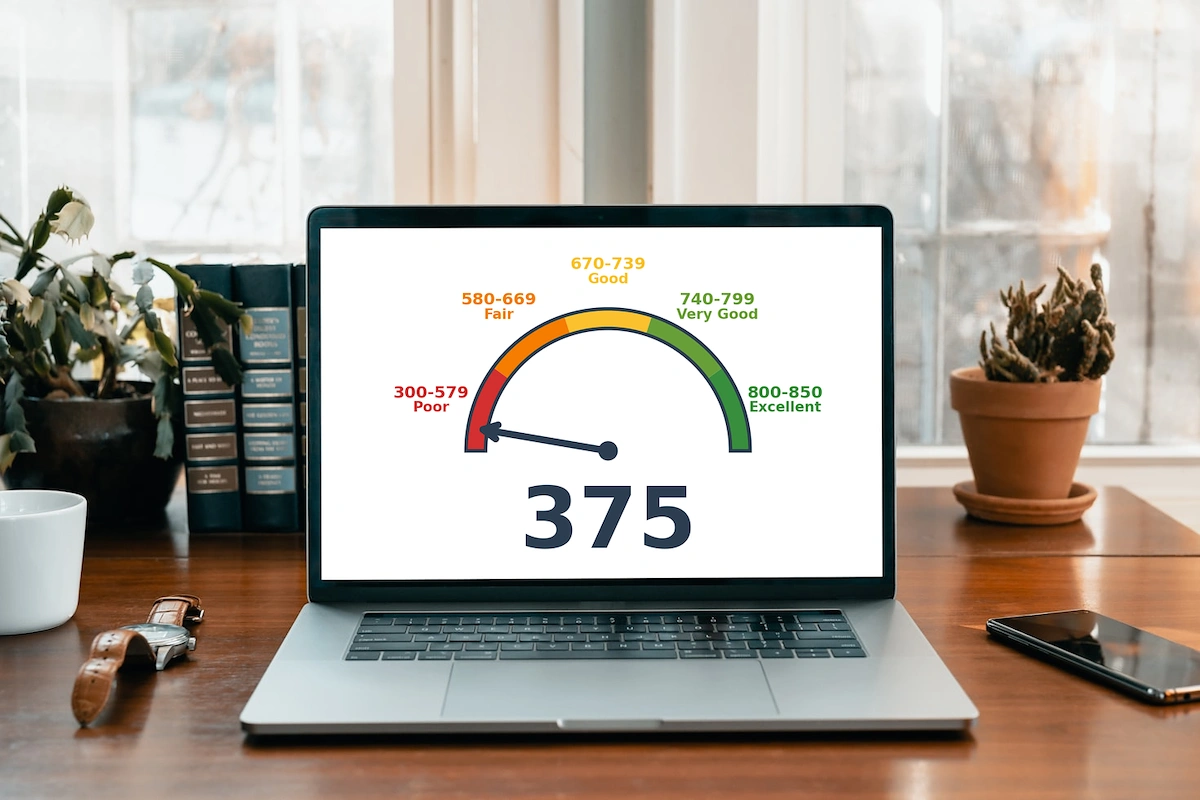
Kudos has partnered with CardRatings and Red Ventures for our coverage of credit card products. Kudos, CardRatings, and Red Ventures may receive a commission from card issuers. Kudos may receive commission from card issuers. Some of the card offers that appear on Kudos are from advertisers and may impact how and where card products appear on the site. Kudos tries to include as many card companies and offers as we are aware of, including offers from issuers that don't pay us, but we may not cover all card companies or all available card offers. You don't have to use our links, but we're grateful when you do!
375 Credit score: What You Need to Know in 2025
July 1, 2025


TL;DR
A 375 credit score indicates there's considerable room for growth on your financial journey. It falls squarely within the "Poor" FICO score category, which is a clear signal to begin crafting a strategy for credit improvement.
What Does a 375 Credit Score Mean?
A credit score of 375 is considered very poor. On the widely used FICO scoring model, which ranges from 300 to 850, a 375 falls squarely into the lowest category. This signals to lenders that you represent a significant credit risk. It's a challenging position, often indicating a history of serious financial difficulties, such as delinquencies, defaults, or accounts in collections.
Financially, this score can create significant hurdles. Securing new credit, whether a loan or a credit card, will be extremely difficult, and any offers you do receive will likely come with very high interest rates and unfavorable terms. It can even affect your ability to rent an apartment or set up utilities without a hefty deposit. While the situation is serious, understanding your standing is the first step toward building a stronger financial future.
Who Has a 375 Credit Score?
While a 375 credit score is significantly below the average for any demographic, scores do tend to increase with age. According to 2023 data from Experian, the average FICO score rises with each successive generation:
- Generation Z (ages 18-26): 680
- Millennials (ages 27-42): 690
- Generation X (ages 43-58): 709
- Baby Boomers (ages 59-77): 745
- Silent Generation (ages 78+): 760
Credit Cards With a 375 Credit Score
A credit score of 375 falls into the "poor" credit range, which can significantly hinder your ability to qualify for most traditional credit cards. Lenders view this score as a high-risk indicator, meaning they are less likely to approve your application due to concerns about your ability to manage debt responsibly. Consequently, your options will likely be restricted to specific products designed for bad credit, such as secured credit cards that require a cash deposit as collateral.
Kudos offers AI-powered tools like the Explore Tool and Dream Wallet, which provide personalized credit card recommendations based on your preferences or actual spending habits. These features help you find suitable options by allowing you to compare cards side-by-side and understand how different choices might impact your credit score.
Auto Loans and a 375 Credit Score
A 375 credit score places you in the deep subprime category, which can make it difficult to get approved for an auto loan. If you are approved, you can expect to face some of the highest interest rates offered by lenders.
According to a 2025 analysis, average auto loan rates vary significantly by credit score:
- Super-prime (781-850): 5.25% for new cars and 7.13% for used cars
- Prime (661-780): 6.87% for new cars and 9.36% for used cars
- Non-prime (601-660): 9.83% for new cars and 13.92% for used cars
- Subprime (501-600): 13.18% for new cars and 18.86% for used cars
- Deep subprime (300-500): 15.77% for new cars and 21.55% for used cars
Mortgages at a 375 Credit Score
With a 375 credit score, traditional mortgage options are essentially unavailable. Government-backed loans, often the most lenient, have minimums a 375 score won't meet. FHA loans require a score of at least 500, while most lenders offering VA or USDA loans look for scores of 580 or higher. According to mortgage requirement data, very few loans are approved for scores under 600.
A very low credit score drastically impacts loan terms. Lenders see low scores as high risk, resulting in much higher interest rates that add thousands to a home's total cost. You would also face higher insurance premiums, stricter underwriting, and fewer loan choices. Lenders may also cap the loan amount, limiting the price of homes you can afford.
What's in a Credit Score?
Figuring out what goes into your credit score can feel like trying to solve a complex puzzle, but it's primarily based on a handful of key financial habits. The most common factors include:
- Your payment history tracks whether you have paid past credit accounts on time.
- Credit utilization is the percentage of your available credit that you are currently using.
- The length of your credit history considers the age of your oldest account and the average age of all your accounts.
- Having a healthy mix of credit types, such as credit cards and installment loans, can positively impact your score.
- Recent credit inquiries and newly opened accounts can temporarily lower your score.
How to Improve Your 375 Credit Score
While a 375 credit score indicates significant financial challenges, it is not a permanent setback, and you can see meaningful improvement with consistent, positive habits. By focusing on the core factors that make up your score, you can begin the process of rebuilding your creditworthiness. Here are four key actions you can take to start raising your score:
- Establish automatic bill payments. Your payment history is the most significant factor in your credit score, so making consistent, on-time payments is the most important step you can take. Setting up automatic payments ensures you never miss a due date, which is fundamental to building a positive history and recovering from a low score.
- Reduce your credit utilization ratio. Aim to use less than 30% of your available credit, as high balances signal risk to lenders and heavily weigh down your score. Paying down your balances shows that you can manage debt responsibly, which is a crucial signal when your score is low.
- Become an authorized user. You can ask a trusted person with a strong credit history to add you as an authorized user on one of their well-managed credit cards. This allows their positive payment history and low credit utilization to appear on your credit report, helping to build your own credit file.
- Monitor your credit reports. Obtain your free credit reports and review them carefully for any errors or signs of fraud, which can unfairly damage your score. Disputing and removing inaccuracies is one of the quickest ways to see a potential score increase when you're starting from a low number.
To help you manage your cards and maximize your financial health on this journey, the free AI-powered browser extension from Kudos can provide personalized recommendations and support.

Supercharge Your Credit Cards
Experience smarter spending with Kudos and unlock more from your credit cards. Earn $20.00 when you sign up for Kudos with "GET20" and make an eligible Kudos Boost purchase.
Editorial Disclosure: Opinions expressed here are those of Kudos alone, not those of any bank, credit card issuer, hotel, airline, or other entity. This content has not been reviewed, approved or otherwise endorsed by any of the entities included within the post.




























.webp)
.webp)
.webp)
%20(1).webp)
.webp)


.webp)
.webp)
%20(1).webp)